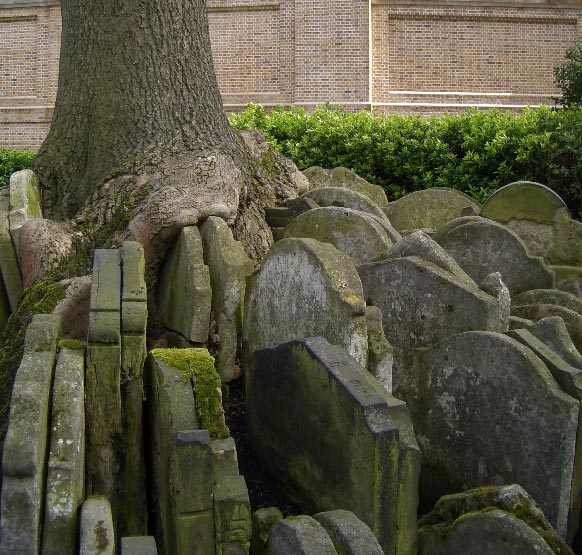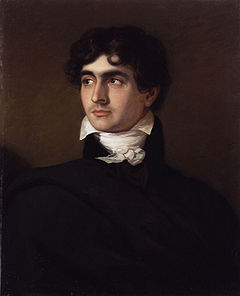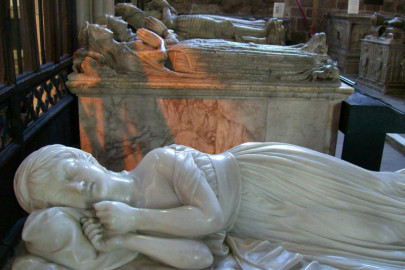
Thomas Hardy, as a young man, was tasked with a job that was extraordinarily well matched to his morbidly repining tendencies. Whilst working as a trainee architect in London, he’d overseen the disinterment and removal of bodies from St Pancras Churchyard. A plaque commemorates his task:
During the 1860s the Midland Railwayline was being built over part of the original St. Pancras Churchyard. Blomfield [Hardy’s boss] was commissioned by the Bishop of London to supervise the proper exhumation of human remains and dismantling of tombs. He passed this unenviable task to his protegé Thomas Hardy in c.l865. Hardy would have spent many hours in St. Pancras Churchyard during the construction of the railway, overseeing the careful removal of bodies and tombs from the land on which the railway was being built.
The incident came to be memorialised in Hardyesque fashion. Headstones cleared from the churchyard were stacked in an undisturbed area and a tree has grown up through them. It’s an ash known as The Hardy Tree (the photo is from this excellent site):
Every aspect of the story – from the obliterations of progress to the ironies unknowingly dispensed by nature – seems to contain the sort of detail and theme Hardy loved to dwell on, cheerfully cheerless. It may have been an inspiration behind a poem, The Levelled Churchyard, though I feel sure it influenced his imagination in other ways. How could it not?
Hardy would almost certainly not have known about the tree; but he did know ones that did similar work, as we see here in The Transformations:
Portion of this yew
Is a man my grandsire knew,
Bosomed here at its foot:
This branch may be his wife,
A ruddy human life
Now turned to a green shoot.These grasses must be made
Of her who often prayed,
Last century, for repose;
And the fair girl long ago
Whom I often tried to know
May be entering this rose.So, they are not underground,
But as nerves and veins abound
In the growths of upper air,
And they feel the sun and rain,
And the energy again
That made them what they were!
I wandered through St Pancras Churchyard in the course of a walk around my part of London (I’m walking a lot at the moment). Hardy’s task and his Tree seemed emblematic of much I’d seen. London has constantly experienced disturbance to its fabric, new things have always sprouted up in the midst of the old (‘Portion of this yew / Is a man my grandsire knew…’).
The whole Kings Cross and St Pancras area is experiencing one of these characteristic irruptions. The extent of development has to be seen to be believed. However, the sensitivity displayed to what’s already on the site is admirable: surviving structures are being incorporated, sometimes very cleverly, into a contemporary transport hub.
The amazing new St Pancras is now complete (the Hotel is opening next month and I can’t wait to have a nose around). A refurbished King’s Cross station looks as if it will be at least as big a treat: at last, its Grade I listing is becoming immediately understandable. (And just down the road, old Euston is still mourned…).
But in this particular bit of London it’s not just the buildings and landscapes that persist, if often transformed. One structure in St Pancras Churchyard has had an unexpected influence: the centrepiece of Sir John Soane‘s family tomb was the inspiration for Giles Gilbert Scott’s red telephone box.
St Pancras Churchyard is also the burial place of John Polidori, author of The Vampyre, which founded the literary genre. It’s already a place of pilgrimage for feminists and fans of the Romantic (Mary Wollstonecraft’s grave is there, a meeting place for her daughter, the future Mary Shelley, and Percy Bysshe*). I wonder whether it’s now on the itinerary of fans of Twilight? If more teenage vampire fans knew what he looked like he might get some visitors:
There’s clearly more than one species of undead to be encountered in London (‘they are not underground / But as nerves and veins abound / In the growths of upper air…’). Sometimes one is tempted to feel that to live in London is to declare, like Hardy, ‘I Have Lived with Shades‘.
* The Shelleys knew Polidori through Byron, whose physician he was. The Vampyre was written alongside Mary Shelley’s Frankenstein following a wet but productive few days spent in a villa on Lake Geneva during the climatically awful summer of 1816.













what an excellent ramble! I have always been interested in St Pancras old church since reading about it in Iain Sinclair’s Lights Out for the Territory (I think) and discovering that it might be the oldest church in Britain with all sorts of famous people interred there. I haven’t seen it since all the rebuilding began. I liked it before when it was marooned in a sea of sooty railway arches and mewling destitutes, it was very gothic.
I’d forgotten St Pancras Churchyard appeared in Lights Out For The Territory. I must dig it out and see what Sinclair had to say.
I believe the site is the oldest occupied by a church but nothing remains of its early foundation and only a little of the site’s medieval church (it may have been victim of another Victorian re-development!).
The Churchyard is now quite tidy and the surroundings too. And since I first walked down it about fifteen years ago, the canal has gone from being a haunt for miscreants to a place safe even for roller-bladers (at least in daylight hours, mostly).
Fabulous post Gaw, with so much to take in. And you’ve picked up on some really obscure details of London’s history and heritage. Lovely to learn about the tree and the inspiration for the design of the traditional red telephone box.
A wonderful ramble in every sense.
London never for a moment ceases rebuilding itself, does it?
Susan and Brit, there’s so much to see in that area, as well as some decent places to have a drink and something to eat, that it justifies a day out.
It is amazing how much St Pancras and King’s Cross have changed over the last few years. I look forward to visiting the new St Pancras hotel. I was lucky enough to have a look around before the refurbishment. The staircase was remarkable.
Both of today’s posts are fascinating. The references here to Hardy’s London days pushed me to revisit part of Claire Tomalin’s biography ‘The Time-Torn Man’. It appears that even before Hardy commenced the task of moving graves, Mary Shelley had already removed the bodies of her mother and father, but left the monument and the body of her father’s second wife intact, no doubt for Hardy to complete the job. Was Mrs Godwin Number 2 relocated to the same grave as Shelley’s mother and father, or did Mary block the move?
Tomalin records that the movement of bodies was done at night behind a hoarding and using flare lamps. Many coffins fell apart as they were brought out, and Hardy was present when a collapsed coffin gave up one skeleton and two skulls. A 19th Century 2-for 1 deal? It might give Tesco ideas for introducing an undertaking service.
John, thanks for that insight into graveyard logistics! I’d be surprised if Tesco hasn’t already got into funerals – good margins and a steady trade.